One of the enduring conversations among Viet cooks focuses on this topic: How do you fry cha gio well? If you’re unfamiliar with these delicious rolls, they are a super popular that you’d find at parties, restaurants, nosh sessions. They are a good time, celebration food. They’re often filled with a sparkly mixture of bean thread (cellophane) noodles and seafood and pork, and there are vegetarian options too.
Cha gio originated in Saigon, and their old school name is cha gio Sai Gon. Nowadays in Vietnam, the rolls also go by nem ran, a term favored in Hanoi. Adding to the name confusion is the fact that in English, some Viet-Americans call them “Vietnamese eggrolls” though they are not made with Cantonese eggroll skins. Imperial roll, a translation of pâté impérial (their moniker in French) is more neutral and speaks to their luxurious-seeming flavor despite being made from humble ingredients. Use the term that you're comfortable. For me, I stick with the original cha gio (“chah yaw” or “chah zaw” for southern and northern pronunciation, respectively).
Back to the initial question. Professional and home cooks alike have many tricks and theories on how to keep cha gio from busting open, achieving a handsome color, and creating a crisp, slightly chewy texture. There are Viet cooks who’ll say that the trick to making crisp cha gio is to use wheat-based lumpia or Chinese spring roll skins (banh trang Tau). Break away from the traditional banh trang rice paper altogether, they advocate. In Vietnam, there’s also a net-like wrapper called banh trang re, which fries up lacy, crispy, albeit kinda greasy.
Last year on Phu Quoc island, I encountered a group of women rolling cha gio up in small wrappers usually used for Chinese-style po pia (similar to Shanghai spring roll and lumpia); the package was labeled banh bo bia.
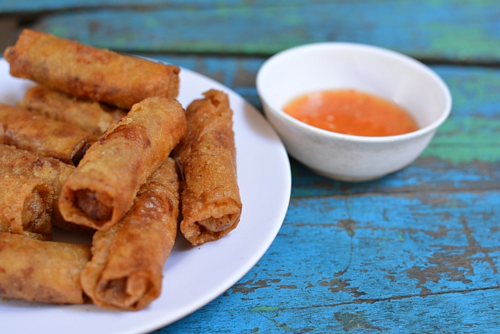
Going the way of a wheat-based wrapper is certainly the easy path but cha gio sing with the delicateness of rice paper; as a bonus, they’re gluten-free! Admittedly, frying cha gio imperial rolls with rice paper is a royal pain in the butt because you may make a fabulous filling and roll what look like lovely stubby cigars only to have the frying be a mess. I’ve fried a lot of cha gio over the years and never have I thrown one away. I’ve tried lumpia and spring roll skins but always return to rice paper simply because cha gio taste better with rice paper. It is their natural way of being. They don’t have to look perfect to taste perfect. A few tips for your cha gio frying adventures:
Choose rice paper wisely -- Originally, Vietnamese banh trang rice paper mainly contained rice, water and salt. Nowadays, it includes tapioca starch to make it thin and easier to soften and manipulate. Some brands have only tapioca starch. I’m fond of the 3 Ladies brand (a popular brand at Asian markets and at this writing, Cost Plus World Market), which blends tapioca with rice flour, water and salt. It’s not too thin or thick, is easy to manipulate for create rolls, and is relatively consistent. My friend Eric Banh in Seattle says his cooks at Ba Bar like an all-tapioca banh trang. (For rice paper guidance, see this post.)
My mom also added that rice paper changes all the time. It's hard to find rice paper made with a decent amount of rice these days. "It's like playing the lottery," she said. "You never know but you just have to keep trying." Just keep frying.
Add something to the rice paper dipping liquid – In my mom’s orange notebook of domesticity, I found a hand-written cha gio recipe. The water used to soften and season the rice paper includes rice wine, MSG, starch and sugar. My chef friend Eric Banh suggests that home cooks use 20% beer and 80% water. On the Vietworldkitchen Facebook page, Philoan recommended adding turmeric to the water. Charles Phan of Slanted Door says they use sugar and honey. I’ve used a tablespoon of sugar per cup of water. The bottom line is that people add stuff to the water to facilitate coloring and crisping. Rice and tapioca do not brown easily or quickly on their own.
Build a low-moisture filling – The mixture that fills the rolls are in general, not pre-cooked. However, ingredients like bean thread noodles naturally absorb moisture and swell up during cooking; they act like as sponge. When jicama is used, it’s prepped and squeezed to expel excess moisture. Taro root swells up during cooking too; my chef friend Terrence Khuu steams his before using in the filling whereas other people just grate it. Egg may be employed as a binder. Ground pork, shrimp, tofu, carrot may be part of the mix. They each have different moisture contents, and a good cook considers that when making the filling.
Roll tightly and avoid air bubbles – That is ultimately the goal but it’s hard to achieve with every roll. It depends on the rice paper, temperature of the water, and work surface (try a smooth dish towel or wood cutting board to absorb excess moisture and create a tackier rice paper). Also, make your filling compact and shape it into a nice log before folding and rolling.
Refrigerate before frying -- On Facebook Philoan and Marta recommend refrigerating the rolls before frying. The chilled would work well to regulate the oil temperature, especially if you don’t have a deep-fry thermometer.
Fry twice – Like with Belgian fries, the double frying helps a crisp finish, Eric Banh says. The first is usually at a moderately-low temperature (325F / 160C), the second is at a moderate to moderately-high temperature (350-375F / 175 to 190C). I’ve gotten away with a single fry and then refrying any that may have softened as they sat around cooling. The frying takes a while but surprisingly, not a ton of oil gets absorbed. Be patient. Get a feel for it in your kitchen. That's what's most important.
Also be creative. My brother Dan reminded me that one Christmas we did the refrying in a Nuwave electric oven that he gifted my parents. It was alright.
Accept the blisters – Those weird bubbles form like some sort of alien or weird skin growth. Last week, my friend and stylist Karen Shinto helped me make a mess of cha gio imperial rolls and she described the bubbles as a croaking frog. Most of them go away and/or add to the beautiful crystalline finish of every cha gio.
Last year, Cuong Pham, the owner of Red Boat fish sauce, came for dinner. Leading off the menu was cha gio. When he noticed that I’d use rice paper for the rolls, he gleefully said, “Authentic cha gio with rice paper.” Of course.
NOTE: Dennis and Rosa asked about a cha gio recipe. My favorite, go-to, cha gio recipe is on page 120 in Into the Vietnamese Kitchen. It's based on my mom's recipe and we both use it to this day.
Got a tip or insight to add? Please do because we'll be better cooks for it!













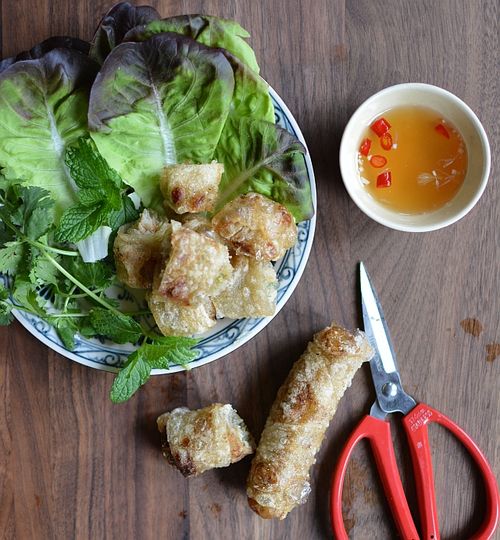
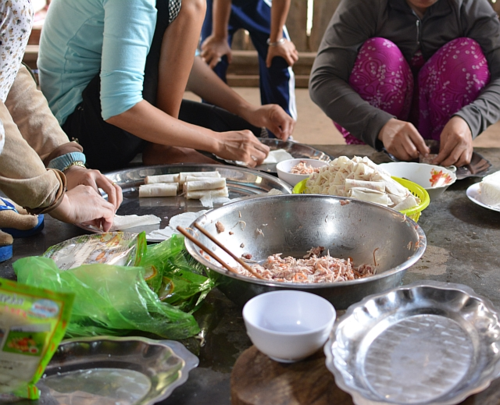
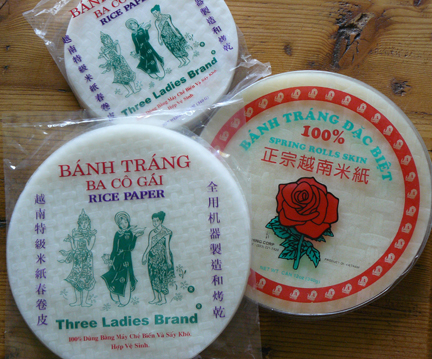
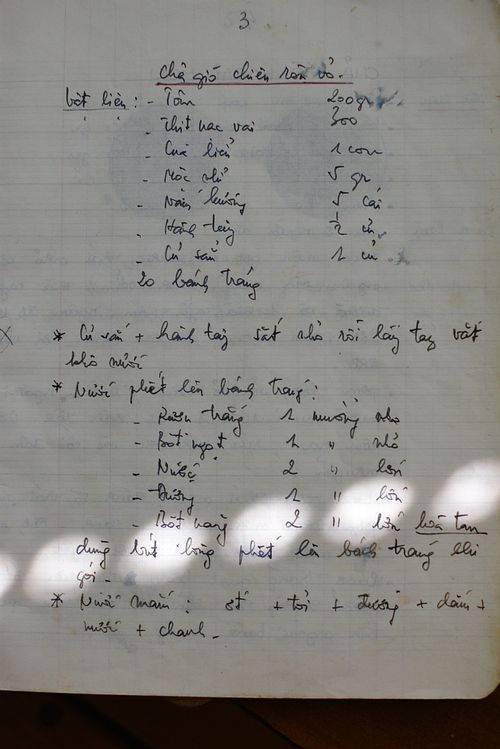




Phyllis says
thanks for this article. I was making about 100 cha gios today for a birthday party. I had a mixture of different rice papers. The ones I had bought at a street market in Hanoi were very thin and pliable and fried up beautifully. The others which I got in local markets wera a varied bunch. One batch of them began to exude a powdery mess in the oil and the cha gios stuck together in the oil. Sure enough, the package listed tapioca as the first ingredient Now I know what to look for when buying more rice papers. I also give them a double fry, but that is because I can't fry that many cha gios for such a big group and so I used the technique that I thought would be used by restaurants. I was happy to see your description of it. Thanks.
Andrea Nguyen says
Wow. You are amazing, Phyllis!!! That's freaky about the ones that came apart. It's really hard to use ingredients purchased in Vietnam. Oye, that's a whole different conversation. But what a treat you offered to people!
Helen says
Hi, Do you have your own recipe? I couldn’t find it on your site. Thanks!
Andrea Nguyen says
I use the recipe in my book, "Into the Vietnamese Kitchen". Your library or bookstore may have it. Amazon surely does. Thanks for asking!
MICHELLE V says
For the double fry method, how long do you fry them for both at low and high heat?
Andrea Nguyen says
It depends on your filling (is it cooked or raw?) and the rice paper. In general the inside will be totally done so you're trying to fry the first time to set the rice paper. I would fry once at 1/2 to 2/3 of the normal time that you'd fry the rolls. Or, fry until the rolls are starting to brown. Then pull them and increase the heat. Again, I'm a single fryer. When I fry in advance for guests, I fry to about 3/4 of the doneness and then let the rolls sit at room temp till the guests arrive and then I refry. It works every time for me. Hope those options help.
Andy says
Lovely tips!
I have a friend that can't have tapioca. Do you know of any brands that only use rice flour? It's been hard to tell from the packaging.
Andrea Nguyen says
No I don't. Maybe in Vietnam but I doubt it. Sorry! :-/
Margaret E Clegg says
I just bought some rice wrappers that have rice and cassava flour. No tapioca. From StarAniseFoods.com
Andrea Nguyen says
Cassava root is used to make tapioca starch. Sometimes tapioca flour is used to denote tapioca starch. There is such a thing as cassava flour, but it's simply the root that's been peeled, dried and ground.
Van Ly says
Hi Andrea, can I freeze cha gio after the first fry and do the second fry when I'm ready to use? If so, should I let it thaw first or fry the frozen once? Thanks!
Andrea Nguyen says
Totally freeze after the first fry! Thaw them then refry. Do not fry them frozen because excess water will make the oil go bezerk. Enjoy!
Fred sershen says
Hi Andrea I have a good ingredient recipe but having trouble getting 12” three sisters brand rice paper to brown correctly. Could you tell me the best ingredient for the water soak and temperature for first and second deep frying. Thank you
Andrea Nguyen says
Fred -- the information you're looking for is already in the post. Thanks for asking! Enjoy your cha gio!
Fred says
Hi Andrea, have you tried doubling up the three sisters wrappers for extra crunch and chewy? If so what was your results. Thank you
Andrea Nguyen says
I've never done that before with the 3 Ladies. I've done that with tissue thin ones from Vietnam.
Mo says
Hi Andrea! Thank you for sharing all the tips. I wanted to know if the rolls could be assembled/rolled the night before and stored in the refrigerator before frying them for my dinner party the next day. Does the quality or crunch suffer? Just trying to get ahead. Have a big menu to conquer day of! Thank you in advance for your help.
Andrea Nguyen says
No. Par-fry them if you're working in advance like that. Have a good party!
Kim Ninh says
Thank you for this article. I add Coke or Pepsi to the rice paper water. This add the crispy golden color to the cha gio. i also double fried them.
Andrea Nguyen says
How much soda do you add to the water? I love the idea.
Nancy says
Any tips for reheating leftover or frozen Cha good without frying them again? I've tried to bake after freezing twice fried and the results were just ok.
Andrea Nguyen says
Refrying is the best with the rice paper wrapped cha gio. The oven turns them into plastic-like sticks.